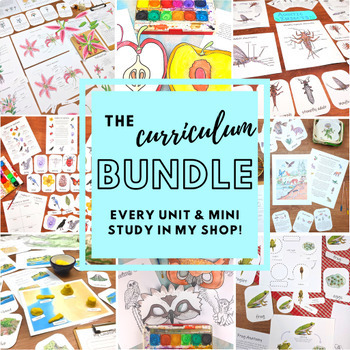Science & Nature Curriculum Bundle: all my units & mini-studies in one bundle!
- Zip
- Easel Activity
Products in this Bundle (32)
showing 1-5 of 32 products
Description
Simply EVERY unit in my shop, in one discounted bundle!
→ This collection includes environmental science-inspired complete units and study materials.
→ It is perfect for homeschooling, nature camps, STEM camps, and earth/environmental science classrooms.
→ All the materials feature my artwork and are based on my experience as an environmental scientist.
*** What age/grade can use these materials?***
These materials were designed with universal design and mixed-age group classroom in mind! All units are adaptable across a range of grade levels. More information about the best age ranges for each product can be found in the product descriptions of each of my units
*** Materials Included ***
Over 1000 pages of science activities, posters, diagrams, worksheets, flashcards, projects, and games! A range of environmental science topics are covered, including watershed science, ecology, wildlife biology, earth science, forestry, botany, bioindicators, STEM skills, and more!
More specifically, it includes my:
Forest Ecology Unit, Pond Ecology Unit, Food Webs unit, Water Cycle unit, Landforms unit, Water Features Unit, Math in the Forest unit, Fun with Fruit unit, Birds of Prey unit, Tree Frogs unit, Science on the River unit, Trees unit, Flowers unit, Glaciers Unit, Science in the Snow unit, Geometry in the Snow unit, Nature Preschool Unit, Pollination Unit, Waterbirds Unit, Desert Ecology Unit, Cactus Unit, Plate Tectonics Unit, Mammals Unit, Arctic Unit, Sun Unit, Reptiles Unit, Soil Science Unit, Rocks and Minerals Unit, & Aquatic Macroinvertebrates Unit.
NOTE: this bundle includes EVEN MORE materials beyond those shown in the listing photos! You can check out the product descriptions for the individual products in this bundle to learn more about each one.
I routinely add new units, and I increase the price of this bundle accordingly when I do. Once you purchase the bundle, be the first to know about my newest units - follow @wildearthlab on Instagram and Facebook for updates about new materials!
*** Please note***
→ FOR PERSONAL/SINGLE CLASSROOM USE ONLY: These materials feature my original artwork and designs. Please do not resell, share, or alter these materials.
→ 1-sided printing on 8.5-inch by 11-inch paper is recommended. Larger paper may affect image quality.
→ You are purchasing a PDF download, no physical items will be shipped.
→The activities in this unit should be completed with adult supervision. Wild Earth Lab is not responsible for the safety of participants completing the activities within this unit.
***Get in Touch***
Contact info and a few free samples of my work are available on my website!
WildEarthLab.com
I’m happy to answer your questions about this item - please don’t hesitate to reach out to me :)


